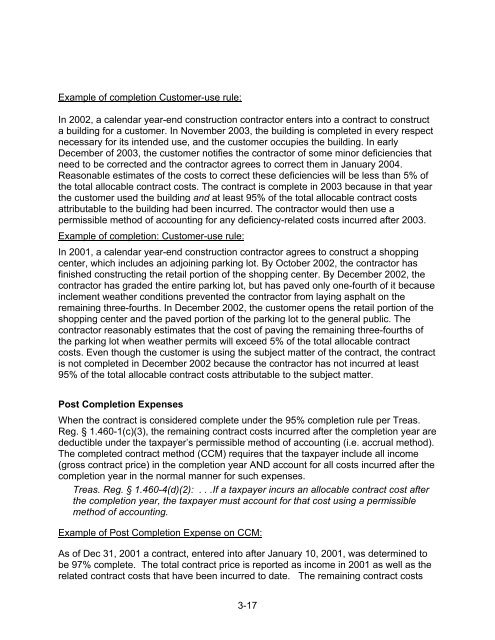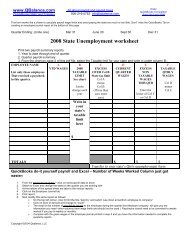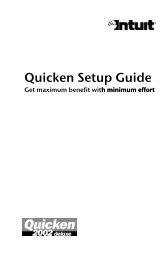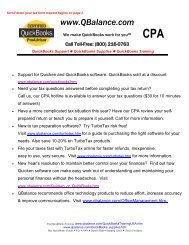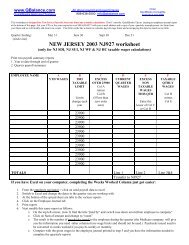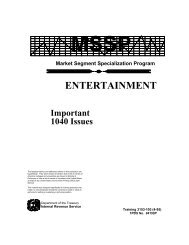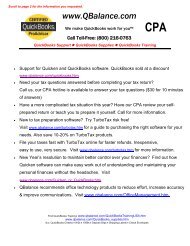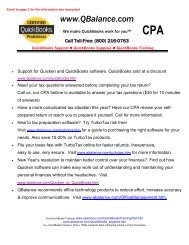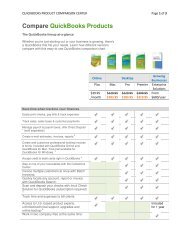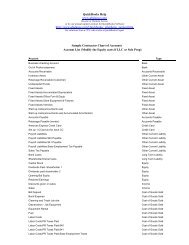Construction Industry - Audit Technique Guide - Uncle Fed's Tax ...
Construction Industry - Audit Technique Guide - Uncle Fed's Tax ...
Construction Industry - Audit Technique Guide - Uncle Fed's Tax ...
Create successful ePaper yourself
Turn your PDF publications into a flip-book with our unique Google optimized e-Paper software.
Example of completion Customer-use rule:In 2002, a calendar year-end construction contractor enters into a contract to constructa building for a customer. In November 2003, the building is completed in every respectnecessary for its intended use, and the customer occupies the building. In earlyDecember of 2003, the customer notifies the contractor of some minor deficiencies thatneed to be corrected and the contractor agrees to correct them in January 2004.Reasonable estimates of the costs to correct these deficiencies will be less than 5% ofthe total allocable contract costs. The contract is complete in 2003 because in that yearthe customer used the building and at least 95% of the total allocable contract costsattributable to the building had been incurred. The contractor would then use apermissible method of accounting for any deficiency-related costs incurred after 2003.Example of completion: Customer-use rule:In 2001, a calendar year-end construction contractor agrees to construct a shoppingcenter, which includes an adjoining parking lot. By October 2002, the contractor hasfinished constructing the retail portion of the shopping center. By December 2002, thecontractor has graded the entire parking lot, but has paved only one-fourth of it becauseinclement weather conditions prevented the contractor from laying asphalt on theremaining three-fourths. In December 2002, the customer opens the retail portion of theshopping center and the paved portion of the parking lot to the general public. Thecontractor reasonably estimates that the cost of paving the remaining three-fourths ofthe parking lot when weather permits will exceed 5% of the total allocable contractcosts. Even though the customer is using the subject matter of the contract, the contractis not completed in December 2002 because the contractor has not incurred at least95% of the total allocable contract costs attributable to the subject matter.Post Completion ExpensesWhen the contract is considered complete under the 95% completion rule per Treas.Reg. § 1.460-1(c)(3), the remaining contract costs incurred after the completion year aredeductible under the taxpayer’s permissible method of accounting (i.e. accrual method).The completed contract method (CCM) requires that the taxpayer include all income(gross contract price) in the completion year AND account for all costs incurred after thecompletion year in the normal manner for such expenses.Treas. Reg. § 1.460-4(d)(2): . . .If a taxpayer incurs an allocable contract cost afterthe completion year, the taxpayer must account for that cost using a permissiblemethod of accounting.Example of Post Completion Expense on CCM:As of Dec 31, 2001 a contract, entered into after January 10, 2001, was determined tobe 97% complete. The total contract price is reported as income in 2001 as well as therelated contract costs that have been incurred to date. The remaining contract costs3-17


